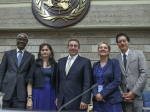The second meeting of the Open-Ended Committee of Permanent Representatives (OECPR-2) to the UN Environment Programme (UNEP) advanced preparations for the upcoming second UN Environment Assembly (UNEA-2), which will address the theme of 'Delivering on the Environmental Dimension of Agenda 2030.'
 19 February 2016: The second meeting of the Open-Ended Committee of Permanent Representatives (OECPR-2) to the UN Environment Programme (UNEP) advanced preparations for the upcoming second UN Environment Assembly (UNEA-2), which will address the theme of ‘Delivering on the Environmental Dimension of Agenda 2030.’
19 February 2016: The second meeting of the Open-Ended Committee of Permanent Representatives (OECPR-2) to the UN Environment Programme (UNEP) advanced preparations for the upcoming second UN Environment Assembly (UNEA-2), which will address the theme of ‘Delivering on the Environmental Dimension of Agenda 2030.’
Described by UN General Assembly (UNGA) President Mogens Lykketoft as one of the first key checkpoints “on the road to 2030,” OECPR-2 convened from 15-19 February 2016, in Nairobi, Kenya, and was attended by approximately 400 delegates, including ministers and vice-ministers. The meeting included plenary sessions and drafting groups addressing two key themes on the UNEA-2 agenda: UNEP’s role in the implementation of the Sustainable Development Goals (SDGs); and emerging issues in the health-environment nexus.
Presenting a concept note on 2030 Agenda implementation, UNEP Executive Director Achim Steiner emphasized the need to enhance synergies across the UN system, and especially between UNEA and the High-Level Political Forum on sustainable development (HLPF). While many delegates highlighted UNEP’s role in setting norms and standards for global environment issues, diverging views were expressed on its position within the broader “SDG landscape.” Delegates disagreed on UNEP’s role in: promoting international partnerships to facilitate developing countries’ access to technologies for environmental monitoring; assessment and review; and implementation of the Paris Agreement on climate change, among other areas.
Delegates negotiated on text for draft resolutions on: natural capital management in sustainable development; illegal trade in wildlife and wildlife products; the protection of the environment in conflict-affected areas, including specific references to the conflicts in Syria and Palestine; the promotion of sustainable consumption and production (SCP) programmes; the establishment of a single joint voluntary trust fund for the Basel, Rotterdam and Stockholm (BRS) Conventions to enhance an integrated approach to the sound management of chemicals and wastes; the enhancement of UNEP’s work in facilitating cooperation and synergies among biodiversity-related multilateral environmental agreements (MEAs); and a new draft resolution on ‘Wasted Food Reduction, Rescue and Diversion.’
While many of the draft resolution texts remained heavily bracketed by the close of negotiations, many welcomed the high level of engagement by Member States. Consultations during an intersessional period are expected to produce consensus on outstanding issues, ahead of UNEA-2.
Issues that were agreed upon, or came close to finalization at OECPR-2, included: investing in human capacity for sustainable development; implementation of the SAMOA Pathway and the SDGs in small island developing States (SIDS); marine plastic debris and microplastics; and sustainable management of coral reefs.
With regard to health-environment linkages, delegates exchanged views on UNEP’s Global Thematic Report ‘Healthy Environment, Healthy People.’ The report highlights the high levels of premature deaths around the world attributed to environmental factors, including an estimated seven million deaths annually due to exposure to indoor and outdoor air pollution. Speaking at the meeting, Steiner drew attention to the links between the environment and outbreaks of both the Ebola and Zika viruses. Specific OECPR-2 draft resolutions on this topic highlighted issues of: marine plastic debris and microplastics; sound management of chemicals and waste; environmentally-sound lead battery recycling; SCP; and air quality. Many delegates called for a strong message on the health-environment nexus in the UNEA-2 outcome document, with some also highlighting security aspects of this nexus.
The meeting did not take up the issue of UNEP’s stakeholder engagement policy, which has been on the OECPR and UNEA agenda for the last two years. A key outstanding issue is the call by China and several other delegations for the participation of Major Groups and Stakeholders to be on the basis of the “no objection” practice. During the closing plenary, UNEA President Oyun Sanjaasuren reported on informal consultations she had conducted on this issue, saying progress had been made on a compromise proposal that will be forwarded to UNEA-2.
UNEA is the world’s highest-level decision-making body on the environment and includes the universal membership of all 193 UN Member States. UNEA-2 will be complimented by 26 side events, eight exhibitions and two symposia addressing financing for sustainable development and the environmental dimension of humanitarian crises. It will also include a business dialogue as well as a Sustainable Innovation Expo (SIE2016). UNEA-2 will take place from 23-27 May 2016, in Nairobi, Kenya. [IISD RS Summary Report and Analysis of OECPR-2] [IISD RS Coverage of OECPR-2] [UNEA-2 Website] [UNEP Press Release, 15 February] [UNEP Press Release, 19 February] [UN Press Release] [UNEA Website]